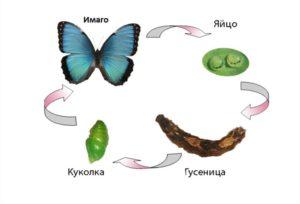Types of insects: what you need to know about the numerous representatives of the species
Insects are constant companions of people. They are presented in a huge variety, more than a million species. They are found almost everywhere, except for the coldest regions.
Content
Who are insects
Insects are a class of invertebrate arthropods that have a body with chitin. They differ in structure, shape, size and lifestyle.
All of them go through a life cycle with complete or incomplete transformation. The cycle of complete transformation consists of 4 stages:
- egg;
- larva;
- pupa;
- adult individual (imago).
In an incomplete cycle, there is no pupal stage.
| Body structure | Three sections: head, thorax and abdomen. Each segment has its own part. |
| Exoskeleton | Outer dense cut of the body and limbs with chitin. There are growths, a spike, folds, hairs. |
| Colors | Diverse. They can be structural, bright, metallic, with patterns and stripes. |
| Head | With antennae, mouth limbs, organs of vision. |
| Chest | Consists of three segments, legs with knees and a hip are attached. |
| Wings | Two pairs, with a frame and thin fabric, are reinforced with veins. |
| Abdomen | Consists of a number of segments with appendages. |
Types of insects
Insects are the most numerous members of the animal class. In the selection are some of the species that are the most common and often found.
The role of insects in life
In nature, everything is connected and harmoniously arranged. Therefore, each insect has a specific role. It doesn't always work for people.
Harmful insects
Depending on the lifestyle, there are insects that bring only harm. They can feed on human waste products, plant juices and fruits. Here are some examples:
- whitefly. The little white flies are actually noxious pests in large numbers;
- goldtail. A pest of fruit trees, the hairy caterpillar is also harmful;
- silverfish. Insects that spoil stocks, paper products, products. They don't bite people.
Relatively harmful
This is a series of insects that can act in two ways. They are often harmful, but also useful in their way of life. So, the most striking examples of this are harmful insects that can bite or sting people, but at the same time protect the site from pests:
- mosquito. An insect similar to a mosquito and also feeds on blood. But it processes organic matter, thereby enriching the soil;
- scolopendra. They bite painfully and cause irritation. But they hunt flies, mosquitoes and fleas;
- crickets. Relatively safe vegetarians, which can ruin the harvest if they are massively distributed.
Useful
Contrary to misconceptions, not all insects harm people. There are many useful inhabitants of the house and garden. Although the appearance of these bright representatives may surprise:
- flycatcher. An unpleasant-looking insect that rarely bites and does not spoil food. Destroy a lot of small pests;
- mantis. Predator, which helps to destroy pests on the site;
- daphnia. Small crustaceans that live in stagnant water bodies filter the soil and are food for fish.
Differing in socialization
All insects are conditionally divided into two categories: solitary and social. According to the names, they either live on their own and interact only in the case of reproduction, or exist in a colony, family, clusters.
social insects
This includes those who live in an organized family and their own hierarchy. These species have a device and their own occupation of each family member.
solitary insects
Those that do not live in colonies or families. They prefer to live alone and not meet their own kind unnecessarily.
Conclusion
Insects are an integral part of nature, diverse and amazing. Among them there are individuals that harm people or are beneficial. There are disgusting in appearance and very cute. But each of these consciousnesses has its own important role.
Previous